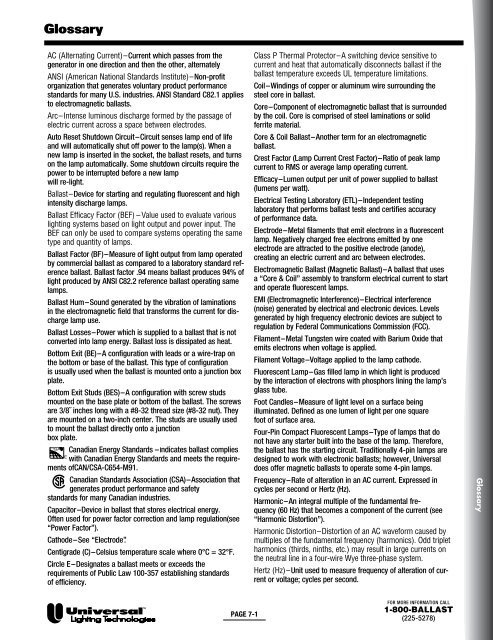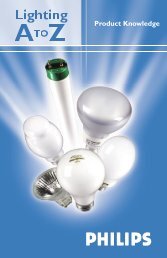triad® electronic ballasts - Conserve-A-Watt Lighting, Inc
triad® electronic ballasts - Conserve-A-Watt Lighting, Inc
triad® electronic ballasts - Conserve-A-Watt Lighting, Inc
You also want an ePaper? Increase the reach of your titles
YUMPU automatically turns print PDFs into web optimized ePapers that Google loves.
GlossaryAC (Alternating Current)–Current which passes from thegenerator in one direction and then the other, alternatelyANSI (American National Standards Institute)–Non-profitorganization that generates voluntary product performancestandards for many U.S. industries. ANSI Standard C82.1 appliesto electromagnetic <strong>ballasts</strong>.Arc–Intense luminous discharge formed by the passage ofelectric current across a space between electrodes.Auto Reset Shutdown Circuit–Circuit senses lamp end of lifeand will automatically shut off power to the lamp(s). When anew lamp is inserted in the socket, the ballast resets, and turnson the lamp automatically. Some shutdown circuits require thepower to be interrupted before a new lampwill re-light.Ballast–Device for starting and regulating fluorescent and highintensity discharge lamps.Ballast Efficacy Factor (BEF) – Value used to evaluate variouslighting systems based on light output and power input. TheBEF can only be used to compare systems operating the sametype and quantity of lamps.Ballast Factor (BF)–Measure of light output from lamp operatedby commercial ballast as compared to a laboratory standard referenceballast. Ballast factor .94 means ballast produces 94% oflight produced by ANSI C82.2 reference ballast operating samelamps.Ballast Hum–Sound generated by the vibration of laminationsin the electromagnetic field that transforms the current for dischargelamp use.Ballast Losses–Power which is supplied to a ballast that is notconverted into lamp energy. Ballast loss is dissipated as heat.Bottom Exit (BE)–A configuration with leads or a wire-trap onthe bottom or base of the ballast. This type of configurationis usually used when the ballast is mounted onto a junction boxplate.Bottom Exit Studs (BES)–A configuration with screw studsmounted on the base plate or bottom of the ballast. The screwsare 3/8˝ inches long with a #8-32 thread size (#8-32 nut). Theyare mounted on a two-inch center. The studs are usually usedto mount the ballast directly onto a junctionbox plate.Canadian Energy Standards –Indicates ballast complieswith Canadian Energy Standards and meets the requirementsofCAN/CSA-C654-M91.Canadian Standards Association (CSA)–Association thatgenerates product performance and safetystandards for many Canadian industries.Capacitor–Device in ballast that stores electrical energy.Often used for power factor correction and lamp regulation(see“Power Factor”).Cathode–See “Electrode”.Centigrade (C)–Celsius temperature scale where 0°C = 32°F.Circle E–Designates a ballast meets or exceeds therequirements of Public Law 100-357 establishing standardsof efficiency.Class P Thermal Protector–A switching device sensitive tocurrent and heat that automatically disconnects ballast if theballast temperature exceeds UL temperature limitations.Coil–Windings of copper or aluminum wire surrounding thesteel core in ballast.Core–Component of electromagnetic ballast that is surroundedby the coil. Core is comprised of steel laminations or solidferrite material.Core & Coil Ballast–Another term for an electromagneticballast.Crest Factor (Lamp Current Crest Factor)–Ratio of peak lampcurrent to RMS or average lamp operating current.Efficacy–Lumen output per unit of power supplied to ballast(lumens per watt).Electrical Testing Laboratory (ETL)–Independent testinglaboratory that performs ballast tests and certifies accuracyof performance data.Electrode–Metal filaments that emit electrons in a fluorescentlamp. Negatively charged free electrons emitted by oneelectrode are attracted to the positive electrode (anode),creating an electric current and arc between electrodes.Electromagnetic Ballast (Magnetic Ballast)–A ballast that usesa “Core & Coil” assembly to transform electrical current to startand operate fluorescent lamps.EMI (Electromagnetic Interference)–Electrical interference(noise) generated by electrical and <strong>electronic</strong> devices. Levelsgenerated by high frequency <strong>electronic</strong> devices are subject toregulation by Federal Communications Commission (FCC).Filament–Metal Tungsten wire coated with Barium Oxide thatemits electrons when voltage is applied.Filament Voltage–Voltage applied to the lamp cathode.Fluorescent Lamp–Gas filled lamp in which light is producedby the interaction of electrons with phosphors lining the lamp’sglass tube.Foot Candles–Measure of light level on a surface beingilluminated. Defined as one lumen of light per one squarefoot of surface area.Four-Pin Compact Fluorescent Lamps–Type of lamps that donot have any starter built into the base of the lamp. Therefore,the ballast has the starting circuit. Traditionally 4-pin lamps aredesigned to work with <strong>electronic</strong> <strong>ballasts</strong>; however, Universaldoes offer magnetic <strong>ballasts</strong> to operate some 4-pin lamps.Frequency–Rate of alteration in an AC current. Expressed incycles per second or Hertz (Hz).Harmonic–An integral multiple of the fundamental frequency(60 Hz) that becomes a component of the current (see“Harmonic Distortion”).Harmonic Distortion–Distortion of an AC waveform caused bymultiples of the fundamental frequency (harmonics). Odd tripletharmonics (thirds, ninths, etc.) may result in large currents onthe neutral line in a four-wire Wye three-phase system.Hertz (Hz)–Unit used to measure frequency of alteration of currentor voltage; cycles per second.GlossaryPAGE 7-1FOR MORE INFORMATION CALL1-800-BALLAST(225-5278)




